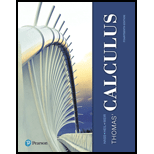
EBK THOMAS' CALCULUS
14th Edition
ISBN: 9780134654874
Author: WEIR
Publisher: VST
expand_more
expand_more
format_list_bulleted
Question
Chapter A.3, Problem 19E
To determine
The new position of the particle.
Expert Solution & Answer
Want to see the full answer?
Check out a sample textbook solution
Students have asked these similar questions
Consider the graphs of y = f(x) and y = g(x) in the given diagram
y= f(x).
y = g(x)
Evaluate (f+g)(2) -5
Determine all for which g(x) < f(x)
Determine all for which f(x) +3 = g(x)
I) For what value(s) of x does g(x) = -4? Separate multiple answers with commas as needed.
J) Give the interval(s) of such that g(x) > 0. Use the union symbol between multiple intervals.
K) Give the interval(s) of such that g(x) <0. Use the union symbol between multiple intervals.
need help on B
Chapter A.3 Solutions
EBK THOMAS' CALCULUS
Ch. A.3 - In Exercises 1 and 2, a particle moves from A to B...Ch. A.3 - Prob. 2ECh. A.3 - Describe the graphs of the equations in
Ch. A.3 - Prob. 4ECh. A.3 - Prob. 5ECh. A.3 - Prob. 6ECh. A.3 - Prob. 7ECh. A.3 - Prob. 8ECh. A.3 - Prob. 9ECh. A.3 - Prob. 10E
Ch. A.3 - Prob. 11ECh. A.3 - In Exercises 9–15, write an equation for each line...Ch. A.3 - Prob. 13ECh. A.3 - Prob. 14ECh. A.3 - Prob. 15ECh. A.3 - In Exercises 16 and 17, find the line’s x-and...Ch. A.3 - In Exercises 16 and 17, find the line’s x-and...Ch. A.3 - Is there anything special about the relationship...Ch. A.3 - Prob. 19ECh. A.3 - Prob. 20ECh. A.3 - Prob. 21ECh. A.3 - Prob. 22ECh. A.3 - Prob. 23ECh. A.3 - Prob. 24ECh. A.3 - Prob. 25ECh. A.3 - Prob. 26ECh. A.3 - Prob. 27ECh. A.3 - Prob. 28ECh. A.3 - Prob. 29ECh. A.3 - Prob. 30ECh. A.3 - Describe the regions defined by the inequalities...Ch. A.3 - Describe the regions defined by the inequalities...Ch. A.3 - Prob. 33ECh. A.3 - Describe the regions defined by the inequalities...Ch. A.3 - Prob. 35ECh. A.3 - Write a pair of inequalities that describe the...Ch. A.3 - Prob. 37ECh. A.3 - Prob. 38ECh. A.3 - Prob. 39ECh. A.3 - Prob. 40ECh. A.3 - Prob. 41ECh. A.3 - Insulation According to the figure in Exercise 41,...Ch. A.3 - 43. Pressure under water The pressure p...Ch. A.3 - Reflected light A ray of light comes in along the...Ch. A.3 - Prob. 45ECh. A.3 - Prob. 46ECh. A.3 - Prob. 47ECh. A.3 - Show that the triangle with vertices A(0, 0), ,...Ch. A.3 - Prob. 49ECh. A.3 - Prob. 50ECh. A.3 - Prob. 51ECh. A.3 - Prob. 52E
Knowledge Booster
Learn more about
Need a deep-dive on the concept behind this application? Look no further. Learn more about this topic, calculus and related others by exploring similar questions and additional content below.Similar questions
- 4. Use the properties of limits to help decide whether each limit exists. If a limit exists, fi lim (2x²-4x+5) a) x-4 b) lim 2 x²-16 x-4x+2x-8arrow_forward7. The concentration of a drug in a patient's bloodstream h hours after it was injected is given by 0.17 h Ah= h²+2' Find and interpret lim A(h). Remember, the answers to word problems should always be given in a complete h→00 sentence, with proper units, in the context of the problem.arrow_forward#2arrow_forward
- 2. We want to find the inverse of f(x) = (x+3)² a. On the graph at right, sketch f(x). (Hint: use what you know about transformations!) (2 points) b. What domain should we choose to get only the part of f (x) that is one- to-one and non-decreasing? Give your answer in inequality notation. (2 points) - c. Now use algebra to find f¯¹ (x). (2 points) -4- 3- 2 1 -4 -3 -2 -1 0 1 -1- -2- --3- -4 -N- 2 3 4arrow_forward1. Suppose f(x) = 2 4 == x+3 and g(x) = ½-½. Find and fully simplify ƒ(g(x)). Be sure to show all x your work, write neatly so your work is easy to follow, and connect your expressions with equals signs. (4 points)arrow_forwardFind the ane sided limit lim 2 x+1-3x-3arrow_forward
Recommended textbooks for you
 Calculus: Early TranscendentalsCalculusISBN:9781285741550Author:James StewartPublisher:Cengage Learning
Calculus: Early TranscendentalsCalculusISBN:9781285741550Author:James StewartPublisher:Cengage Learning Thomas' Calculus (14th Edition)CalculusISBN:9780134438986Author:Joel R. Hass, Christopher E. Heil, Maurice D. WeirPublisher:PEARSON
Thomas' Calculus (14th Edition)CalculusISBN:9780134438986Author:Joel R. Hass, Christopher E. Heil, Maurice D. WeirPublisher:PEARSON Calculus: Early Transcendentals (3rd Edition)CalculusISBN:9780134763644Author:William L. Briggs, Lyle Cochran, Bernard Gillett, Eric SchulzPublisher:PEARSON
Calculus: Early Transcendentals (3rd Edition)CalculusISBN:9780134763644Author:William L. Briggs, Lyle Cochran, Bernard Gillett, Eric SchulzPublisher:PEARSON Calculus: Early TranscendentalsCalculusISBN:9781319050740Author:Jon Rogawski, Colin Adams, Robert FranzosaPublisher:W. H. Freeman
Calculus: Early TranscendentalsCalculusISBN:9781319050740Author:Jon Rogawski, Colin Adams, Robert FranzosaPublisher:W. H. Freeman
 Calculus: Early Transcendental FunctionsCalculusISBN:9781337552516Author:Ron Larson, Bruce H. EdwardsPublisher:Cengage Learning
Calculus: Early Transcendental FunctionsCalculusISBN:9781337552516Author:Ron Larson, Bruce H. EdwardsPublisher:Cengage Learning

Calculus: Early Transcendentals
Calculus
ISBN:9781285741550
Author:James Stewart
Publisher:Cengage Learning

Thomas' Calculus (14th Edition)
Calculus
ISBN:9780134438986
Author:Joel R. Hass, Christopher E. Heil, Maurice D. Weir
Publisher:PEARSON

Calculus: Early Transcendentals (3rd Edition)
Calculus
ISBN:9780134763644
Author:William L. Briggs, Lyle Cochran, Bernard Gillett, Eric Schulz
Publisher:PEARSON

Calculus: Early Transcendentals
Calculus
ISBN:9781319050740
Author:Jon Rogawski, Colin Adams, Robert Franzosa
Publisher:W. H. Freeman


Calculus: Early Transcendental Functions
Calculus
ISBN:9781337552516
Author:Ron Larson, Bruce H. Edwards
Publisher:Cengage Learning
The Law of Cosines; Author: Professor Dave Explains;https://www.youtube.com/watch?v=3wGQMyaWoLA;License: Standard YouTube License, CC-BY
Law of Sines and Law of Cosines (4 Examples); Author: Mario's Math Tutoring;https://www.youtube.com/watch?v=T--nPHdS1Vo;License: Standard YouTube License, CC-BY